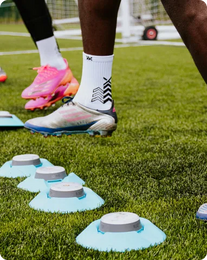Wondering what the foundational performance characteristics of any top-tier athlete is? Strength, stamina, power, agility, stability, coordination, and mental resilience are crucial. Depending on the sport, the list could go on forever.
However, one often-overlooked element deserves a spot on this list: Velocity.
Understanding velocity is crucial for you as an athlete because it helps you move quickly and directly, allowing you to change direction swiftly and maintain high performance even under the constraints of directional effort. This edge can be the difference between winning and losing, giving you a significant competitive advantage. But more on that later.
Keep reading to uncover what velocity training is, why it’s effective, how to implement it into your training routine, and the best drills to unlock its full benefits.
What is Velocity?
To grasp velocity-based training, it's essential to differentiate between velocity and speed, as both relate to motion but in distinct ways.
Speed refers to how fast an object or person is moving. For instance, running 10 meters per second is your speed. Velocity, on the other hand, measures both how fast and in which direction something moves. For athletes, knowing your velocity helps you understand your speed in a specific direction.

For a sprinter, speed might indicate they can run 100 meters in 10 seconds. However, velocity provides a more detailed picture by showing how quickly they can change lanes or make turns while maintaining speed. This nuanced understanding can be the difference between winning and losing.
In simple terms, speed is about how fast you go, while velocity includes the direction of your movement.
What is Velocity-Based Training?
Velocity-based training combines agility and strength training by using the speed of your movements to optimize your workouts. Instead of just lifting heavy weights, velocity-based training adjusts the weight based on how fast you can move it, ensuring practical training.
Unlike traditional routines like weight training, which often centers around lifting heavy weights or achieving a specific number of repetitions, velocity-based training uses the velocity at which you move to guide your training decisions.
Why is Velocity-Based Training Effective?
“Regular” training can be effective, but, if your goal is power, it often lacks the detail and precision that velocity-based training routines can offer. It provides real-time feedback on how fast you're moving, allowing you to make immediate adjustments. For example, if you're moving a weight too slowly, it might be a sign to lighten the load to maintain the desired speed, ensuring optimal performance and reducing injury risk.
It’s safe to say that every athlete has good and bad days. Velocity-based training considers your daily readiness, adjusting the training load based on your performance and the output you have on each given day. Train at your best without overreaching, potentially injuring yourself, underperforming, and not pushing your body to its limits.

Velocity-based training, which focuses on speed of movement, can help athletes develop power and explosiveness. Quick, powerful movements can make all the difference in sports such as sprinting, swimming, and soccer
How to Measure Velocity
There are many devices available to measure your velocity, but nothing quite compares to BlazePod. Through its innovative ‘Pod’ lights and app, athletes can transform their training and seamlessly integrate velocity-based training into their routine.
BlazePod's advanced light technology enhances your ability to perceive, process, and respond quickly. With over 200 drills and endless customization options, BlazePod synchronizes physical and mental training, providing satisfying results that you can track and compare to exceed your athletic goals.
Whether you aim to improve agility, strength, reaction time, or coordination, BlazePod offers access to a global community through its Benchmark feature. Compare your drill times to the community average and, as a team coach, add players to create leaderboards for real-time performance comparison among teammates. BlazePod isn't just a training tool; it's a comprehensive platform for pushing your limits and achieving peak performance.
How to Include Velocity in Your Training
It’s challenging to measure intensity. Trainers and athletes have used One Rep Max (1RM) to test a person’s strength. 1RM stands for "one-rep max." It is the maximum weight you can lift for one repetition of a given exercise. For example, if the heaviest weight you can bench press for one full repetition is 200 pounds, your 1RM for the bench press is 200 pounds. Knowing your 1RM helps you to determine the right weight for your workouts to build strength effectively.
But what if you have some sickness, feeling tired, or are just having a bad day? On its own, they don’t take this into account and the data suffers from inaccuracy.

Traditional training plans, like 1RM, often leave you guessing the correct number of reps and the appropriate weight. This method eliminates the guesswork by helping you find the perfect reps and weight for your goals.
If you want to apply velocity-based training without purchasing specific data-backed products, you can go manual and figure it out yourself. The key is to always strive to move the weight as fast as possible:
- Pick a weight and move it at your maximum speed.
- If the weight feels too light and you move faster than the target velocity, increase the weight.
- If the weight feels too heavy and you move slower than the target, decrease the weight.
- Repeat until you find a weight that challenges you to move at your top speed. Once you hit this sweet spot, you're ready to begin your sets.
BlazePod Drills for Velocity-Based Training
While personal preference plays a role, BlazePod stands out as one of the most accurate velocity-based training devices available.
For specific drills that enhance speed, agility, and strength while providing real-time velocity data, BlazePod’s light technology and innovative app are unmatched.
With over 200 drills targeting various exercise goals for different sports, physiotherapy, and general fitness, BlazePod helps you reach your goals, track your progress, and compare your performance globally within one centralized app.
Resistance Band Catch
For this BlazePod drill, set up three Pods in a triangle, spaced 2 meters apart. Secure a resistance band 3 meters away to a sturdy object like a tree, ladder, or pole, and position yourself inside the band. When the drill starts and each Pod lights up, sprint to it, pushing against the resistance band to tap the light as quickly as possible.

This Resistance Band Catch drill demands immense power, intense focus, and a serious commitment to sweat. Are you ready for the challenge?
Russian Twist with Reach
For this drill, attach a Pod to a Functional Adapter strap on a wall or pole 25cm above your head, and place two more Pods 50cm to your right and left. Grab a medicine ball, sit between the Pods, and prepare to challenge your brain, speed, and core. Extend your legs and lean back slightly to engage your core.
When the drill starts, tap each lit Pod with the medicine ball. Continue until time runs out. Compete with friends and teammates and see your global ranking on the leaderboard.

Squat Touch Press Challenge
Grab three Pods and arrange them in a triangle formation, each 1m apart. Position yourself in front of the triangle and start in a 90-degree squat.
React quickly based on the Pods that light up: if the left or right Pod lights up, stay in the squat and turn it off with your foot. If the center Pod lights up, drop into a plank, then jump back into the squat and tap the Pod with your hand. Repeat until the time is up.

Conclusion
Velocity-based training enhances athletic performance by focusing on movement speed rather than just weight. This method improves strategic movement and quick reactions, which are essential for peak performance. BlazePod excels in velocity-based training with its accurate measurements and integrated app featuring over 200 customizable drills. It provides real-time data to track and compare progress, making it the best tool for improving reactive intelligence and overall agility. Explore our recommended drills and experience the BlazePod difference.





















